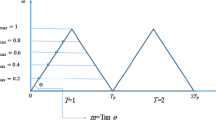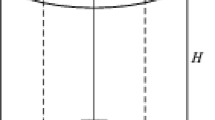Abstract
An experimental and numerical study of the controlled Taylor–Couette flow with free surface is presented in this work. It is aimed to carry out a controlling strategy based upon a combination of free surface effect and an inner cylinder cross section oscillation. Numerical simulations are performed using FLUENT software package for three-dimensional incompressible flows. The basic system geometry is characterized by a height H = 170 mm, an inner and outer cylinders with, respectively, R1 = 31.5 mm and R2 = 35 mm, a ratio of the inner to outer cylinder radii ɳ = 0.9, an aspect ratio Γ = 28.5 and a ratio of the gap to the inner cylinder radius, δ = 0.1. It is established that the first and the second instabilities are delayed. The Taylor vortices and Ekman cells can be destroyed throughout a process applicable for all the flow regimes encountered in the Taylor–Couette flow. The Taylor vortices show a particular sensitivity and can be easily destroyed using low deforming frequencies (f < 3 Hz). The Ekman cells, however, exhibit larger resistance to actuation and substantially higher deforming frequencies (f > 20 Hz) are required for the complete disappearance.










Similar content being viewed by others
Abbreviations
- u r , u θ , u z :
-
Velocity components
- r,θ,z :
-
Cylindrical coordinates
- Ta = \(Re\sqrt \delta\) :
-
Taylor number
- Ta c :
-
Critical Taylor number
- \(\upsilon\) :
-
Kinematic viscosity
- f :
-
Frequency
- R 1, R 2 :
-
Inner and outer cylinder radii
- ρ :
-
Density
- Ω 1, Ω 2 :
-
Inner and outer cylinder angular velocities
- H f :
-
Height of working fluid
- H :
-
Height of cylinders
- \(\dot{m}_{\text{pq}} ,\;\dot{m}_{\text{qp}}\) :
-
Mass transfer between phases
- R max :
-
Maximum limit of the oscillating inner cylinder
- R(t) :
-
Instantaneous radius of the oscillating inner cylinder
- d = R 2 − R 1 :
-
Annular gap
- ε = \(\frac{{R_{ \max } - R_{1} }}{{R_{1} }}\) :
-
Oscillating amplitude
- λ :
-
Axial wave number
- Λ :
-
Axial wavelength
- Γ = \(\frac{{H_{f} }}{d}\) :
-
Aspect ratio
- \(\eta\) = \(\frac{{R_{1} }}{{R_{2} }}\) :
-
Ratio of the radii
- \(\delta\) = \(\frac{{R_{1} }}{d}\) :
-
Gap ratio
- Re = \(\frac{{\varOmega_{1} .R_{1} .d}}{\upsilon }\) :
-
Reynolds number
- α :
-
Volume fraction
- C :
-
Cell Volume
- p, q :
-
Phases (air and liquid)
- T :
-
Cycle of deformation
- d max, d min :
-
Annular gap limits
References
Gl Taylor (1923) Stability of a viscous liquid contained between two rotating cylinders. Philos Trans R Soc Lond A 223:289–343
Couette M (1887) Oscillation tournante d’un solide en révolution contact avec un fluide visqueux. CR Acad Sci 105:1064–1067
Chandrasekhar S (1961) Hydrodynamic and hydromagnetic stability. Oxford at the Clarkndon Press, Oxford
Coles D (1965) Transition in circular Couette flow. J Fluid Mech 21:385. https://doi.org/10.1017/S0022112065000241
Diprima RC, Swinney HL (1981) Instabilities and transition in flow between concentric rotating cylinders. In: Swinney HL, Gollub JP (eds) Hydrodynamic instabilities and the transition to turbulence. Springer, Berlin, pp 139–180
Swinney HL, Gollub JP (1975) Onset of turbulence in a rotating fluid. Phys Rev Lett 35(14):927–930
KoschmiederE L (1993) Benard cells and Taylor vortices. Cambridge University Press, NewYork
Benjamin TB (1978) Bifurcation phenomena in steady flows of a viscous fluid: I. theory. Proc R Soc A 359:1–26
Bouabdallah A (1980) Instabilités et turbulence dans l’écoulement de Taylor–Couette. PhDThesis, INPL, France
Mullin T, Heise M, Pfister G (2017) Onset of cellular motion in Taylor–Couette flow. Phys Rev Fluids 2(8):081901
Poncet S, Haddadi S, Viazzo S (2011) Numerical modeling of fluid flow and heat transfer in a narrow Taylor–Couette–Poiseuille system. Int J Heat Fluid Flow 32(1):128–144
Khamami B (2002) The effect of viscous heating on the stability of Taylor–Couette flow. Fluid Mech 462:111–132
Sobolik V, Jirout T, Havlica J, Kristiawan M (2011) Wall shear rates in Taylor vortex flow. JAFM 2(4):25–31
Wimmer M (1988) Viscous flows and instabilities near rotating bodies. Prog Aerosp Sci 25:43–103
Donnelly RJ (1964) Experiments on the stability of viscous flow between rotating cylinder. III. Enhancement of stability by modulation. Proc R Soc Lond A 281:130–139
Lopez JM, Marques F (2002) Modulated Taylor–Couette flow: onset of spiral modes. Theor Comput Fluid Dyn 16(1):59–69
Lopez JM, Marques F (2002) Spatial and temporal resonances in a periodically forced hydrodynamic system. Phys D 136(3–4):340–352
Aouidef A (1994) Centrifugal instability of pulsed flow. Phys Fluids 6:3665–3676
Barenghi CF, Jones CA (2006) Modulated Taylor–Couette flow. J Fluid Mech 208:127–160
Heinrichs RM, Cannell DS, Ahlers G, Jefferson M (1988) Experimental test of the perturbation expansion for the Taylor instability at various wavevectors. Phys Fluids 31:250–255
Walsh TJ, Wagner WT, Donnelly RJ (1987) Stability of modulated Couette flow. Phys Rev Lett 58:2543–2546. https://doi.org/10.1103/PhysRevLett.58.2543
Walsh TJ (1988) The influence of external modulation on the stability of azimuthal Taylor–Couette flow: an experimental investigation, vol 49–05. Ph. D. thesis. University of Oregon, p 1778
Feugaing MG, Crumeyrolle O and Mutabazi I (2011) Etude expérimentale de l’écoulement de Couette-Taylor avec modulation de fréquence. 20eme CFM
Oualli H, Lalaoua A, Hanchi S and Bouabdallah A (2013) Taylor–Couette flow control using the outer cylinder cross-section variation strategy. Eur Phys J Appl Phys 61(1)
Oualli H, Mekadem M, Lebbi M, Bouabdallah A (2015) Taylor-Couette flow control by amplitude variation of the inner cylinder cross-section oscillation. Eur Phys J Appl Phys 71(1):11102. https://doi.org/10.1051/epjap/2015140232
Lalaoua A, Bouabdallah A (2016) On the onset of Taylor vortices in finite-length cavity subject to a radial oscillation motion. J Appl Fluid Mech 9(4):1887–1896
Mahamadia A and Bouabdellah A (2003) Ecoulement de Tylor-Couette en géométrie finie sur à surface libre. Can J Chem Eng
Author information
Authors and Affiliations
Corresponding author
Ethics declarations
Conflict of interest
The authors declare that they have no conflict of interest.
Additional information
Technical Editor: Jader Barbosa Jr., Ph.D.
Publisher's Note
Springer Nature remains neutral with regard to jurisdictional claims in published maps and institutional affiliations.
Rights and permissions
About this article
Cite this article
Abdelali, A., Oualli, H., Rahmani, A. et al. Experiment and numerical simulation of Taylor–Couette flow controlled by oscillations of inner cylinder cross section. J Braz. Soc. Mech. Sci. Eng. 41, 259 (2019). https://doi.org/10.1007/s40430-019-1758-z
Received:
Accepted:
Published:
DOI: https://doi.org/10.1007/s40430-019-1758-z




